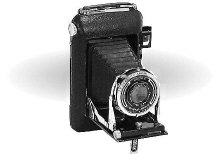| |

Note: Comments relate to the Regent (I), since I have not worked on a
Regent II.
GENERAL
- Because
of the sleek design of the Regent, you may find that your experience
in maintaining other Kodak folders is a little insufficient. All components
fold up into or are enclosed within the body structure, often in novel
ways.
BODY
- Regents
have bodies are made of steel and aluminum. The body is covered in real
Morocco leather. As a bookbinder familiar with similar leatherwork,
I was amazed at how durable and permanently fixed the leather was on
my Regent. The leather cover can be cleaned and dressed with a high-quality
leather dressing. Black shoe polish can be used to retouch scuffed areas,
but because both of these products contain oils and waxes, save leather
dressing for the last step in maintenance and apply them very carefully
so as to avoid mechanical and optical surfaces. The camera's general
design is such that the leather areas are highlighted throughout with
revealed painted metal edges. There are likely to be many bare metal
spots due to wear. If you are skilled with a small brush, you can retouch
these areas by carefully scraping away all loose paint, then repainting
the bare spots with black model enamel. The metal cover for the ruby
window sliders was originally painted black. Repainting this larger
area with a brush is likely to produce an irregular coating, inconsistent
with the original.
VIEWFINDER
- The Regent
viewfinder is an unusual flipup design that assumes the silhouette of
the body when closed. It is attached by four machine screws into the
body. Both viewfinder lenses can be removed with a small slotted screw
driver, by removing the holddown brackets attached through the sides
of the viewfinder housing. Be sure to note the orientation of the objectives
so you can reinstall them correctly. The paint on the viewfinder cover
is likely to be worn and this can be renewed by removing it and with
careful masking and spray painting skills. Note that to clean the rangefinder
optics the viewfinder must be removed.
RANGEFINDER
- The rangefinder
design is one of the great visual successes of the Regent. It is a separate
system from the viewfinder and is tucked neatly in the contours of the
top part of the body. Access to the rangefinder optics is gained by
removing a panel with the camera back open. This panel is attached by
two screws in the top of the film supply chamber and one small screw
through the wall of the cutout in which the viewfinder sits. The mirrors
of the superimposed rangefinder and the internal sides of viewing windows
can be cleaned with this panel removed.
- (Note
that to access the rangefinder linkage, you must remove the lens and
collapse bellows).
- The rangefinder
mechanism is attached to the focusing rack by a linkage inside the bellows
compartment.
 The focus knob on the baseboard is geared to the rack. At the back of
the rack, the focus arm slides in a channel. The upright part of the
arm has a pin that engages the arm of Cam A, in this drawing, which
rotates on a shaft attached to one of the rangefinder mirrors. The return
action of the focus arm is controlled by the focus return spring, which
sometimes gets disoriented and then loses its influence over the focus
arm. In its correct orientation, the return spring must exert a backward
pressure on the focus arm assembly. Rangefinder adjustment is by the
screws on the focus arm.
The focus knob on the baseboard is geared to the rack. At the back of
the rack, the focus arm slides in a channel. The upright part of the
arm has a pin that engages the arm of Cam A, in this drawing, which
rotates on a shaft attached to one of the rangefinder mirrors. The return
action of the focus arm is controlled by the focus return spring, which
sometimes gets disoriented and then loses its influence over the focus
arm. In its correct orientation, the return spring must exert a backward
pressure on the focus arm assembly. Rangefinder adjustment is by the
screws on the focus arm.
SHUTTER
- The shutter
on Regents is a Compur. The entire shutter/lens assembly can be removed
from the front standard by loosening the retaining ring inside the bellows.
This exposes two screws through the back of the lens standard that hold
the shutter shell in place. After removing the glass, you can flood-clean
the shutter with naphtha.
LENS
- Lenses on
Regents are either a f/4.5 Tessar or a f/3.5 or f/4.5
Xenar. Front and rear elements can be removed and cleaned with standard
gentle cleaning with lens cleaning fluid and lens tissue.
FILM ADVANCE
- The single
winding knob can be lifted to clean under it.
CASE
- Leather
quality for German Kodak cases is high. Mine is of good quality cowhide.
There was considerable green corrosion on the brass parts which I removed
with naphtha. The leather can be treated as noted above for the Morocco
leather camera cover, except of course using brown shoe polish to cover
scuffs. The top often requires restitching which should be done with
a heavy linen thread, if available.
|
|
|



